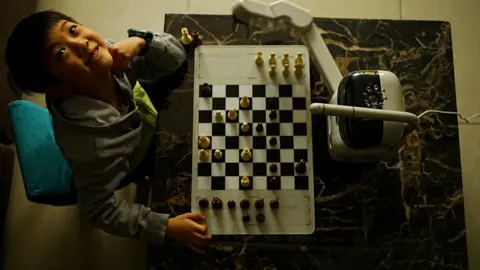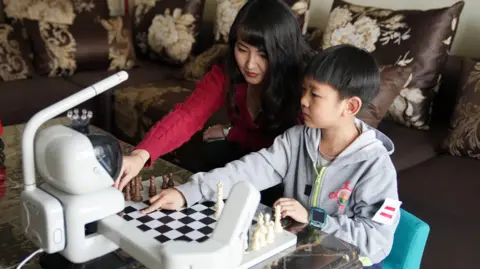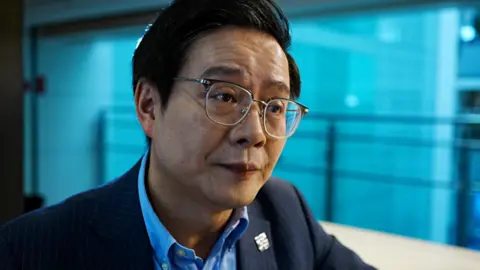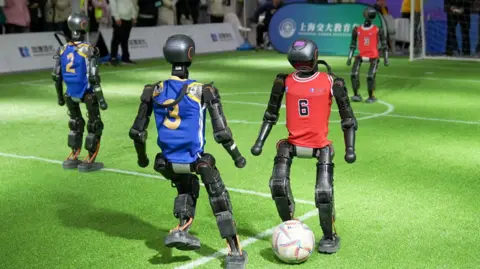China’s corresponding
 BBC/ Xiquing Wang
BBC/ Xiquing WangThe head in his hands, eight -year -old Timmy pleaded as he tried to beat a robot enabled by artificial intelligence in a chess game.
But this was not an exhibition hall or lab he – this robot was living on a coffee table in an apartment in Beijing, along with Timmy.
The first night when he came home, Timmy hugged his little friend of the robot before going to bed. He does not have a name for him – however.
“Likes like a little teacher or a little friend,” the boy said, while he showed his mother the other movement he was considering aboard the chess.
The moments later, the robot withdrew: “Congratulations! You win.” Round eyes staring at the screen, she began re -regulating the parts to start a new game as she continued on Mandarin: “I’ve seen your ability, I will do better next time.”
China is hugging in its effort to become a technology superpower by 2030.
Deepseek, Chinese chatbot progress This drew the world’s attention in January, it was just the first allusion to that ambition.
Money is being poured into businesses that require more capital, promoting internal competition. There are more than 4500 firms that develop and sell it, schools in the capital Beijing are presenting courses for primary and middle students later this year, and universities have increased the number of places available to students studying.
“This is an inevitable tendency. We will coexist with him,” said Timmy’s mum, Yan Xue. “Children should know it as soon as possible. We should not refuse it.”
She is inclined for her son to learn both chess and strategy board game – the robot does both, which convinced her that his $ 800 price was a good investment. Its creators are already planning to add a language learning program.
 BBC/ Joyce Liu
BBC/ Joyce LiuPerhaps this was what the Chinese Communist Party hoped when he declared in 2017 that it would be the “main driving force” of the country’s progress. President Xi Jinping is now betting on him, while a slow economy of the Chinese economy accumulates with the tariff hit by his largest trading partner, the United States.
Beijing plans to invest 10TN Yuan Chinese (1.4tn $; £ 1TN) in the next 15 years while competing with Washington to win the advantage of advanced technology. Funding he received another incentive at the government’s annual political meeting, which is currently in development. This comes at the heels of a 60 billion-II investment fund created in January, just days after the US further tightened export controls for advanced chips and placed more Chinese firms on a black trading list.
But Deepseek has shown that Chinese companies can overcome these barriers. And this is what Silicon Valley and Industry Experts amazed – they did not expect China to reach so quickly.
A race between the dragons
It is a reaction that Tommy Tang is learned after six months of marketing of his firm’s firm’s robot in various races.
Timmy’s car comes from the same company, sensorobot, which offers a wide range of skills – the Chinese state media welcomed a advanced version in 2022 that defeated Masters Grand Chesi in the game.
“Parents will ask about the price, then they will ask where I am from. They expect me to come from SH.BA or Europe. They seem to be surprised that I am from China,” Mr. Tang, smiling. “There will always be one or two seconds of silence when I say I’m from China.”
His firm has sold more than 100,000 robots and now has a contract with a large chain of US supermarkets, Costco.
 BBC/ Xiquing Wang
BBC/ Xiquing WangOne of the secrets to China’s engineering success is its young. In 2020, more than 3.5 million students in the country graduated with degrees in science, technology, engineering and mathematics, better known as the coat.
This is more than any other country in the world – and Beijing is inclined to use it. “Building force in education, science and talent is a common responsibility,” XI told party leaders last week.
Since China opened its economy in the world in the late 1970s, it “has gone through a process of gathering talent and technology,” says Abbott Lyu, Shanghai -based Whalesbot vice president, a firm that makes a toys. “In this era of him, we have many, a lot of engineers, and they are workers.”
Behind him, a dinosaur made of different bricks screams in life. It is being checked through the code collected on a smartphone from a seven year old.
The company is developing toys to help children as young as the three lesson codes. Every packet of brick comes with a coda brochure. Children can then choose what they want to build and learn how to do it. The cheapest toy sells for about $ 40.
“Other countries have his education robots, but when it comes to competition and smart equipment, China is doing better,” insists Mr. Lyu.
Deepseek’s success turned his Director General Liang Wenfeng into a national hero and “worth 10 billion yuan advertising for [China’s] He’s industry, ”he added.
“She has informed the public that he is not just a concept, that he can really change people’s lives. He has inspired the public’s curiosity.”
Six he’s firms of Homegrown, including Deepseek, are now nicknamed China’s Little Dragons from the Internet – others are Unree robotics, deep robotics, brainco, science game and manycore tech.
 BBC/Joyce Liu
BBC/Joyce LiuSome of them were at the last fair of he in Shanghai, where the largest Chinese firms in business showed their advances, from research and rescue robots to a dog like a dog that wandered in halls among visitors.
In a staggering exhibition hall, two teams of humanoid robots fought it in a football game, complete in red and blue jerseys. The machinery fell when they clashed – and one of them was even taken from the field in a closet by their human holder who was inclined to joke.
It was difficult to lose the air of excitement among developers in the wake of Deepseek. “Deepseek means that the world knows we are here,” said Yu Jinjji, a 26-year-old engineer.
‘Capture mode’
But as the world learns about China’s potential, there are also concerns about what it is allowing the Chinese government to learn about its users.
He is hungry for the data – the more foolish, the smarter he does himself and, with about a billion mobile phone users compared to a little more than 400 million in the US, Beijing has a real advantage.
The West, its allies and many experts in these countries believe that data collected from Chinese applications such as Deepseek, Rednote or Tiktok can be achieved by the Chinese Communist Party. Some point to the national intelligence law of the country as evidence of this.
But Chinese firms, including Bytedance, which owns Tiktok, says the law allows the protection of private companies and personal data. However, the suspicion that US users’ data for TIKTOK may end up in the hands of the Chinese government driven Washington’s decision to stop the extremely popular app.
The same fear – where the concerns of intimacy meet the challenges of national security – is hitting Deepseek. South Korea forbidden New Downloads of DeepseekWhile Taiwan and Australia have stopped the app from government -issued equipment.
Chinese companies are aware of these sensitivity and Mr Tang was quick to tell the BBC that “intimacy was a red line” for his company. Beijing also realizes that this will be a challenge in trying to be a global leader in him.
“Deepseek’s rapid growth has caused hostile reactions from some in the West,” pointed out a comment in Beijing run by daily Beijing, adding that “the development environment for China’s models remains very unsafe”.
But China’s firms are not prevented. On the contrary, they believe that good innovation will gain them an undeniable advantage – because it was Deepseek’s claim that Chatgt could rival for a part of the cost that shocked him.
 BBC/ Joyce Liu
BBC/ Joyce LiuSo the engineering challenge is how to do more, for less. “This was our mission impossible,” said Mr. Tang. His company revealed that the robotic arm used to move chess pieces was extremely expensive to produce and would promote the price of about $ 40,000.
So, they tried to use him to help do the work of engineers and improve the production process. Mr. Tang claims to have reduced the cost to $ 1,000.
“That’s innovation,” he says. “Artificial engineering is now integrated into the production process.”
This can have major implications as China applies to a large scale. State media already show factories full of humanoid robots. In January, the government said it would promote the development of humanoid robots with it to help care for its rapid aging population.
XI has repeatedly stated “technological self-confidence” a main goal, which means that China wants to create its own advanced chips, to make up for the restrictions of US exports that can hinder its plans.
The Chinese leader knows that he is in a long race-Beijing daily recently warned that Deepseek’s moment was not a time for “triumphant he” because China was still in “Mode Catch-up”.
President XI is investing a lot in artificial intelligence, robots and advanced technology in preparation for a marathon that he hopes China will eventually win.
